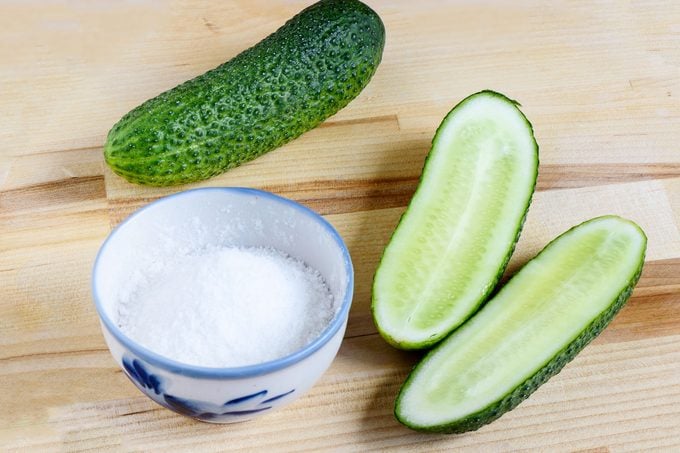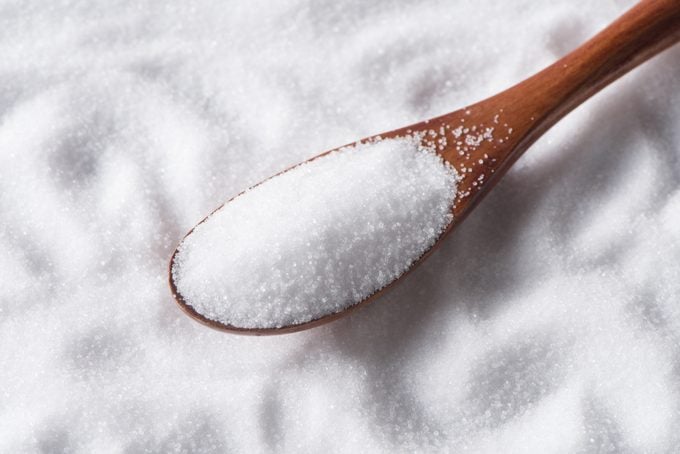What is pickling salt? It sounds specialized, but it's really the simplest form of salt and keeps pickles bright and crisp.
What Is Pickling Salt and How Is It Used?

Salt drives the magical transition from raw vegetable to crunchy pickle. It may play the leading or supporting role depending on the type of pickle you’re making. Still, whether you’re creating a quick pickle for dinner, packing a jar of fridge pickles, canning a large batch or fermenting for an intense sour flavor, you don’t want to reach for your everyday salt shaker. To create beautiful jars of crisp, colorful pickles, you need pickling salt.
What is pickling salt?
Pickling salt has just one ingredient: salt, aka sodium chloride. It doesn’t contain anticaking agents, which can make pickle brine cloudy, or iodine, which can darken pickles. Most types of pickling salt, sometimes labeled canning salt, are extra fine so they dissolve quickly.
In a vinegar brine, salt draws water out of produce to make the pickles more crisp, particularly water-heavy vegetables like cucumbers. It also adds flavor and helps to preserve as it penetrates the cucumber’s cells.
In fermented pickles, salt becomes the essential preserving ingredient. It still helps to ensure crispy pickles and adds flavor, but crucially, it creates a stable brine that controls the speed of fermentation and lets beneficial lactic acid bacteria flourish. Without the right amount of salt, the food you’re trying to ferment will spoil.
How to Use Pickling Salt
In the United States, we typically picture cucumbers when we think of pickles, but pickling salt can preserve all sorts of vegetables and fruits, from cauliflower to strawberries.
Salt plays a key role in most pickle brines, and temporarily doubling down on the salt can make pickles even crunchier. To turn watery produce like pickling cucumbers and watermelon rind into the crispiest pickles, sprinkle pickling salt over raw slices, or dissolve the salt in cool water and pour it over the raw slices. Let the salted vegetable or fruit sit in the refrigerator for a few hours, and then rinse and drain it well. This removes some of the water naturally in the produce, along with most of the added salt.
Then, make the brine, following a safe pickling recipe and using the precise amount of salt and other ingredients. This is especially important when canning, where the proper balance of brine ingredients ensures the pickles are acidic enough to seal in jars, and also when fermenting. During fermentation, the right amount of salt lets beneficial bacteria multiply and preserve while keeping harmful bacteria at bay.
Pickling Salt vs. Kosher Salt

Kosher salt can often be used for pickling, but be sure to check the label closely. Some widely available brands of kosher salt include anticaking ingredients that prevent it from clumping in the box but will turn pickle brine cloudy.
Pure pickling and kosher salts typically dissolve rapidly but have different textures. Fine-grained pickling salt and granulated sugar disappear at about the same speed when heated in water and vinegar. Flaky kosher salt dissolves in room-temperature water with just a few seconds of stirring, making it ideal for unheated brines.
Is there a substitute for pickling salt?
If you’re here because you’re in the middle of a recipe that called for pickling salt, and you’re wondering, what is pickling salt, then you probably need a substitute quick. Luckily, any culinary salt that lists only “salt” as its ingredient can work. If you are substituting another type of pure salt for pickling salt, you need to be sure you are using the right amount.
Fine-grained pickling salt packs more tightly into a tablespoon than flaky kosher salt, so it can weigh almost twice as much. If a pickling recipe calls for one type of salt and you want to substitute another, be sure to do so by weight instead of volume (using a food scale will do the trick!).
Tips for Choosing and Storing Pickling Salt
To make pickling easy, choose the type of salt called for in the recipe or follow a recipe that gives salt in grams. Salt keeps indefinitely when stored properly, so you may want to keep both pickling or canning salt and kosher salt on hand if you make lots of pickles.
Pickling salt should be stored in a cool, dry place. It can be stored in its original packaging, with the opening taped closed to avoid spills, or an airtight container. Because it lacks anticaking agents, it can become clumpy over time, especially if left open next to a loaded water bath or steam canner. If it cakes up, shake the package or stir the salt with a fork to break up large chunks before you measure it for the recipe.


















